Report

Introduction
This is the seventh full edition of Bain’s India Philanthropy Report. The first report in 2010 provided an initial overview of the state of philanthropy in India. Subsequent reports analysed major trends and topics in the philanthropic sector. In 2011 and 2012, we focused on the rise of young philanthropists and the nonprofit causes they were helping to propel. Our 2013 report demystified the complexities of impact assessment in the philanthropic space and identified the factors that ensure each rupee is used as effectively as possible. In 2014, we focused on reproductive, maternal, newborn, child and adolescent health in India and the need to evolve an entire ecosystem to address critical issues in healthcare. In 2015, we looked at the evolution of philanthropy in India and made recommendations on how to sustain and build on its recent momentum by identifying areas that can be improved and offering insights into how stakeholders can address new opportunities.
The focus of this year’s report is the growing importance of the individual philanthropist in the overall landscape of funding for the development sector. It goes beyond analysing how much philanthropists are giving and instead focuses on the evolving approaches that givers are adopting to maximise their philanthropic impact.
Over the years, the Indian philanthropy market has matured. Funds contributed by individual philanthropists have been steadily rising, growing faster than funds from foreign sources and funds contributed through corporate social responsibility (CSR). Philanthropists are also becoming more sophisticated in how they view giving and are proactively adopting new strategies to move the needle towards high-impact results.
Despite these great improvements, the latent potential of a nation of more than a billion people continues to be stymied by developmental barriers. India’s development goals are immense, and the challenges that lie ahead can only be overcome with the efforts of every stakeholder in the ecosystem. The role of the individual philanthropist in overcoming these goals is critical.
We define a framework that outlines the various approaches to philanthropy, showcases a broad segmentation of giving approaches, highlights some common challenges givers continue to face and presents a few practical tips to overcome those challenges. We surveyed 33 individual philanthropists at varying stages of their philanthropic journey across eight major cities, and Dasra conducted in-depth interviews with 23 philanthropists. While each giver adopts different approaches to add value to the sector, some broad patterns emerged from the survey and the interviews. We defined giver cohorts as a method to understand these broad patterns and to help givers self-reflect. Additionally, we observed three critical aspects in the journey of any engaged and effective giver: constant evolution, collaborative action and the constant effort to attain full potential. This report outlines how givers can progress on each of these fronts and provides case studies to help them learn from others’ experiences and make their impact on the development sector even more powerful. It is an attempt to help givers attain their highest philanthropic potential. We hope that it will help them understand the pivotal role individual philanthropists already play today and inspire them along their own philanthropic journeys.
Every giver, no matter how large or small the contribution, plays a vital role in helping India move closer towards its development goals. It is only when every giver reaches his or her full potential that the billion will achieve theirs.
The rise of the individual philanthropist
Despite strong philanthropic momentum, India has a significant way to go to achieve its critical social goals
Philanthropy has been on the upswing in India over the past five years. Although fund-raising continues to be one of the primary concerns in the development sector, it has seen steady growth in the recent past, thanks primarily to private sources. Though the current trend is heartening, a greater push for more philanthropic funding and resources is needed, given that the required scale of development remains significantly large.
In terms of visible outcomes, India still has a long way to go on most fronts despite progressive government schemes such as Beti Bachao Beti Padhao, Jan Dhan Yojana and Swachh Bharat. The country ranked 130 on the Human Development Index in 2014 and 110 on the Sustainable Development Goals (SDGs) Index in 2016, lagging behind its peers on both readings (see Figure 1). Conservative estimates indicate that India will face a financial shortfall of approximately INR 533 lakh crore ($8.5 trillion) if it is to achieve the SDGs by 2030. It needs significant additional funds, along with systemic changes at the policy and service-delivery levels, to achieve these goals. Although the government remains the largest enabler of change, the role of private philanthropy is critical.
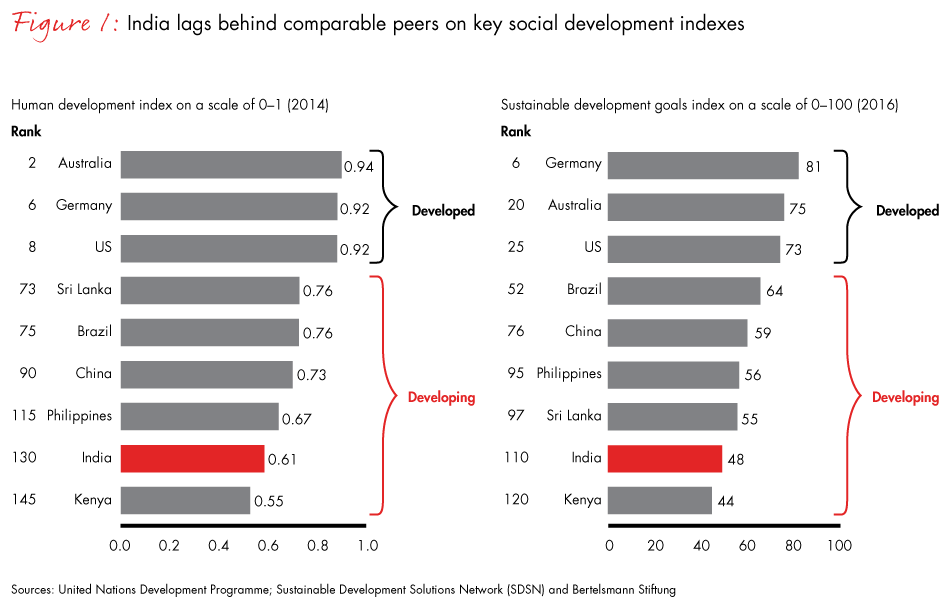
Although the gap is large, funds continue to grow, thanks primarily to private philanthropy
The philanthropic ecosystem has been thriving due to the combined efforts of both the public and private sectors. Overall, total funds for the development sector have grown at a healthy rate of approximately 9% over the past five years, increasing from approximately INR 150,000 crore to approximately INR 220,000 crore. While the government remains the largest contributor (INR 150,000 crore in 2016), its share in total funding has been declining steadily. Private contributions primarily accounted for the INR 70,000 crore five-year growth. Private donations made up 32% of total contributions to the development sector in 2016, up from a mere 15% in 2011 (see Figure 2).
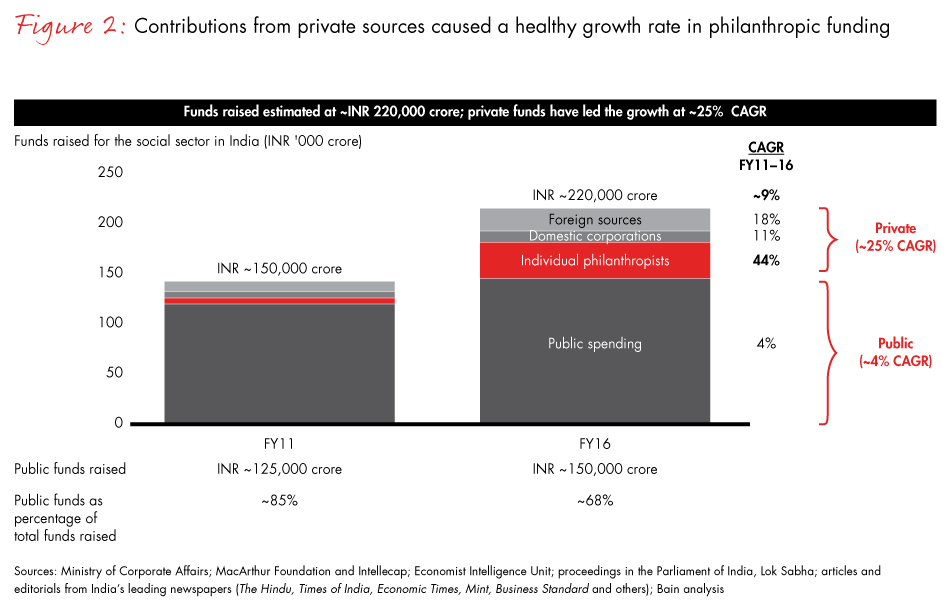
In response to the requirements of the Companies Act 2013, companies have begun focusing on their CSR activities. However, in relative terms, the share of corporate philanthropy in funds raised for the development sector has declined. In 2016, companies accounted for 15% of the total share of private philanthropy, down from 30% in 2011. Looking ahead, the government has proposed amendments to the Companies Act 2013 that seek to provide greater clarity on CSR provisions.
Foreign sources are no longer the biggest sources of private philanthropy. Although philanthropy from foreign sources has continued to increase over the years, the domestic philanthropy market has overtaken it. The rapid growth of philanthropy from individuals bodes well for the sustained growth of Indian philanthropy.
The advent of the individual philanthropist
Philanthropic funding from private individuals recorded a sixfold increase in recent years: approximately INR 36,000 crore in 2016, up from approximately INR 6,000 crore in 2011 (see Figure 3). A large portion of this amount has come from a few established givers who have pledged large sums of their net worth to philanthropy. This uptick in private philanthropy is only expected to increase in the future. Bain’s 2015 India Philanthropy Report indicated that more than 40% of high-net-worth individual givers aimed to increase their contribution towards philanthropy over the next five years.
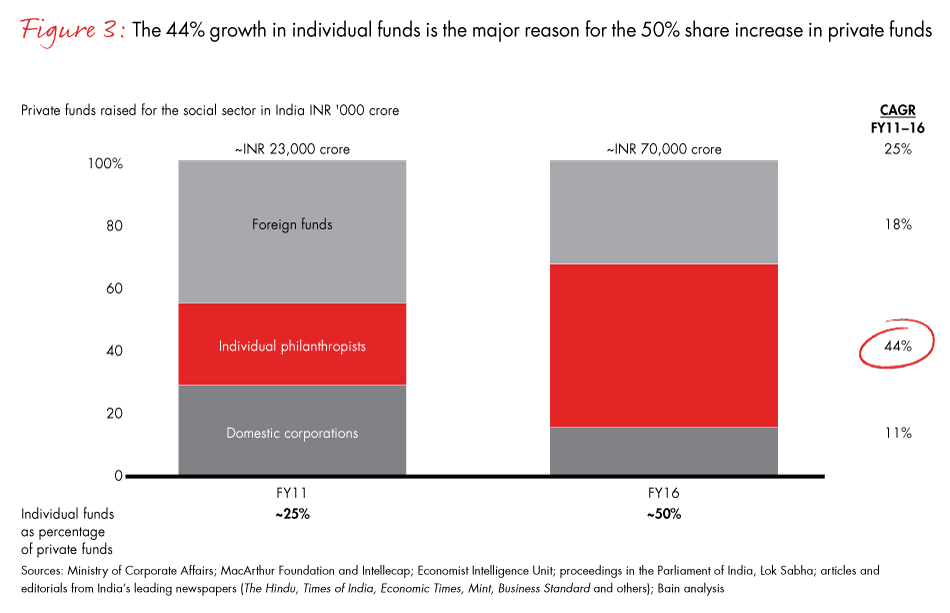
Improving macroeconomic conditions such as the uptick in GDP per capita have no doubt contributed to the increase in ultra-high-net-worth individual (UHNWI) households, leading to more philanthropic activity. The number of UHNWI households has doubled since 2011, and their net worth has tripled during this period. The number of people who have volunteered their time and money between 2009 and 2015 has also increased, up 2 times and 1.5 times, respectively (see Figure 4).
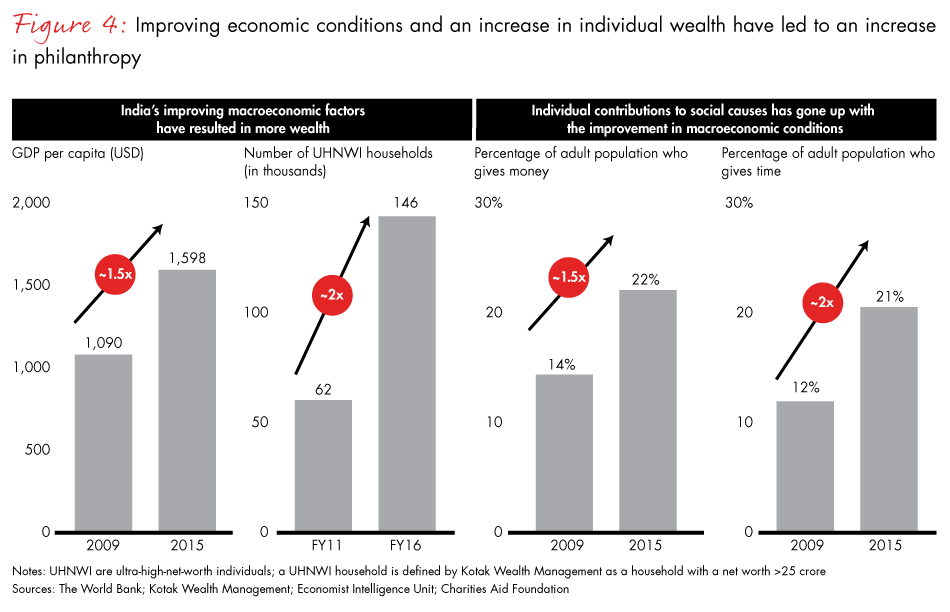
The rise of individual philanthropists marks an important phase in the growth of India’s philanthropy sector. More Indians are becoming wealthier, as reflected in the Forbes billionaires list in which India ranks fourth among countries with the most billionaires. Coupled with the increase in philanthropic proclivities, it becomes even more important to understand the individual philanthropist.
The road to full potential for individual philanthropists
Contributing funds is but one step in a philanthropic journey
Writing a cheque is just the first step in a philanthropic journey. Impactful giving is a multidimensional activity that is different for each philanthropist, shaped in part by his or her unique giving philosophy, life experience, time availability, social interests and goals.
Individual philanthropists adopt a wide range of philanthropic practices. There are some who, unable to invest the requisite time to oversee their philanthropic interests, prefer to be more hands off. Then there are the engaged givers who, in addition to monetary contributions, invest their time and effort.
A philanthropic journey is complex, and there are varied approaches givers can adopt. We have put together a framework to identify the various ways that philanthropists may choose to engage in the sector.
The philanthropic pathways framework
The philanthropic pathways framework lays out a few critical aspects of a giving approach to help givers consciously understand and chart where they are in their own journey, where they want to go, and how to get there. These aspects highlight the broad set of paths givers may take in defining his or her philanthropic approach. They are grouped under the two broad headers of “nature of giving” (see Figure 5) and “engagement with the sector” (see Figure 6). The factors grouped under “nature of giving” highlight how and where philanthropists give and the manner in which their funds are used. The factors under “engagement with the sector” lay out the various ways philanthropists can contribute beyond their financial contributions. The confluence of the two can broadly illustrate the giving approach adopted by philanthropists.
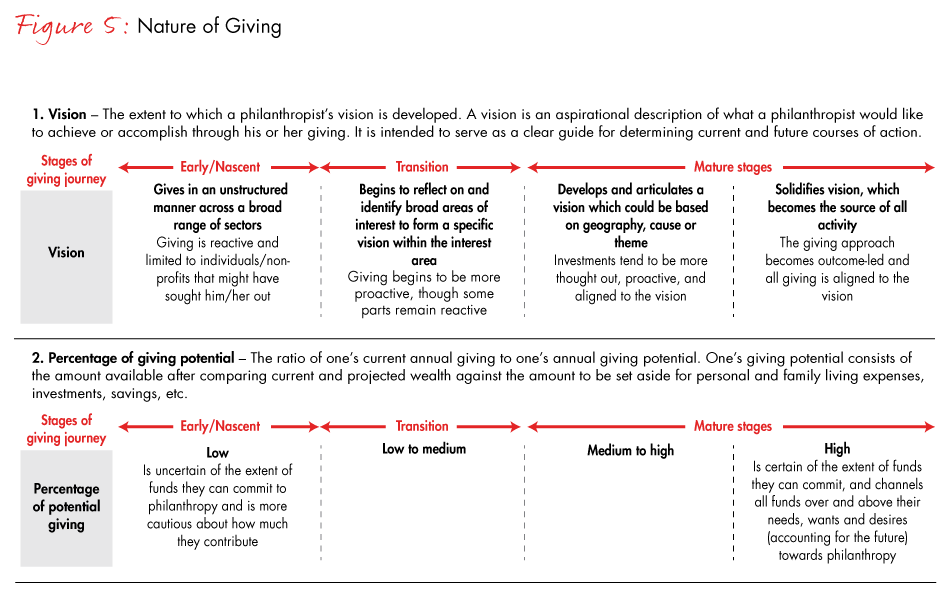
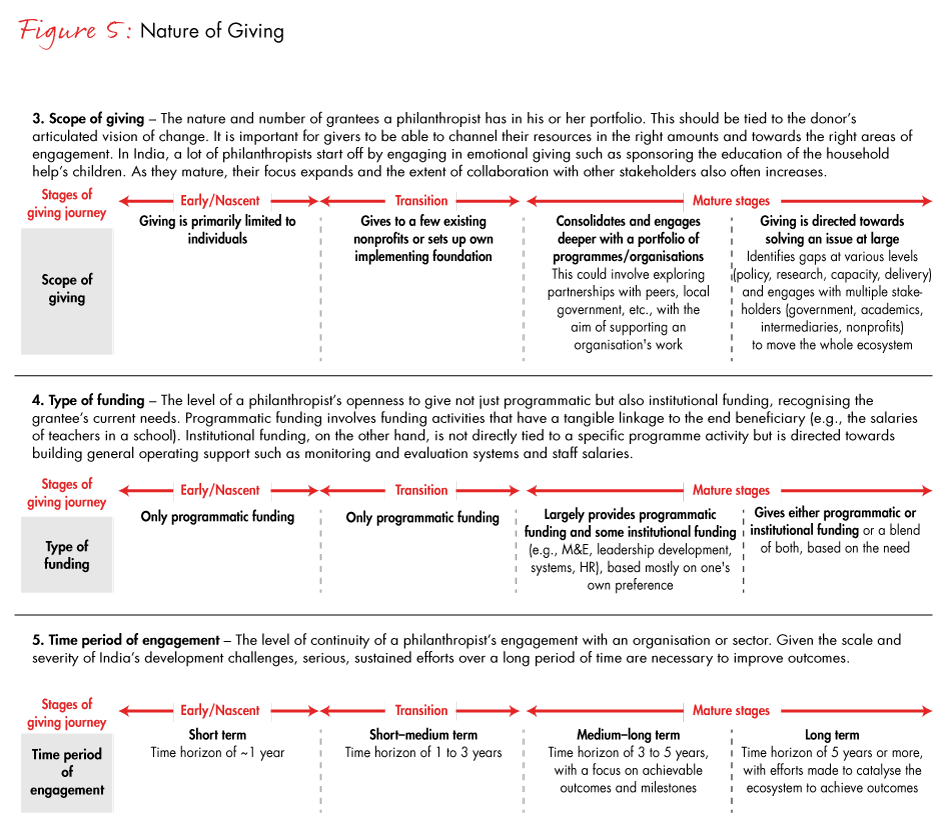
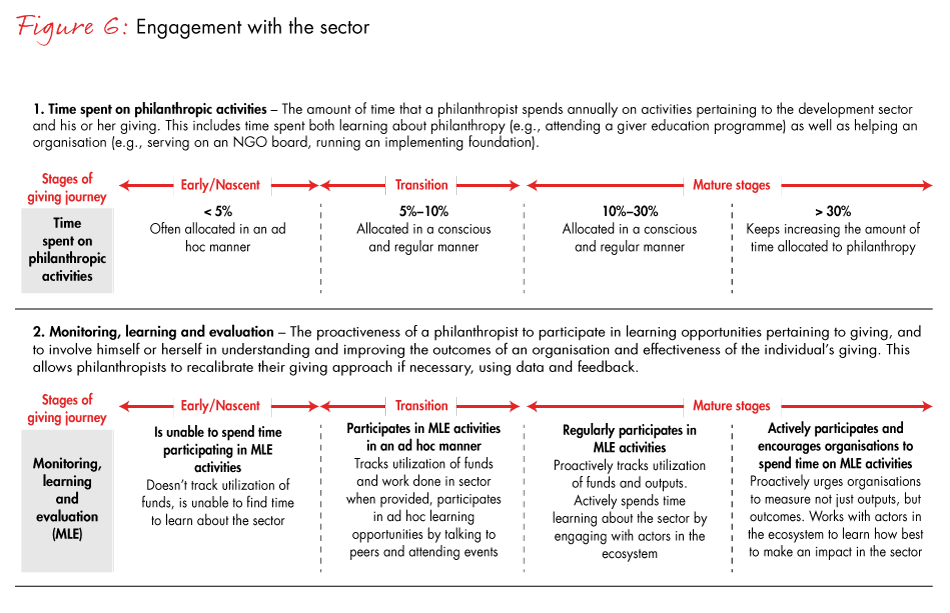
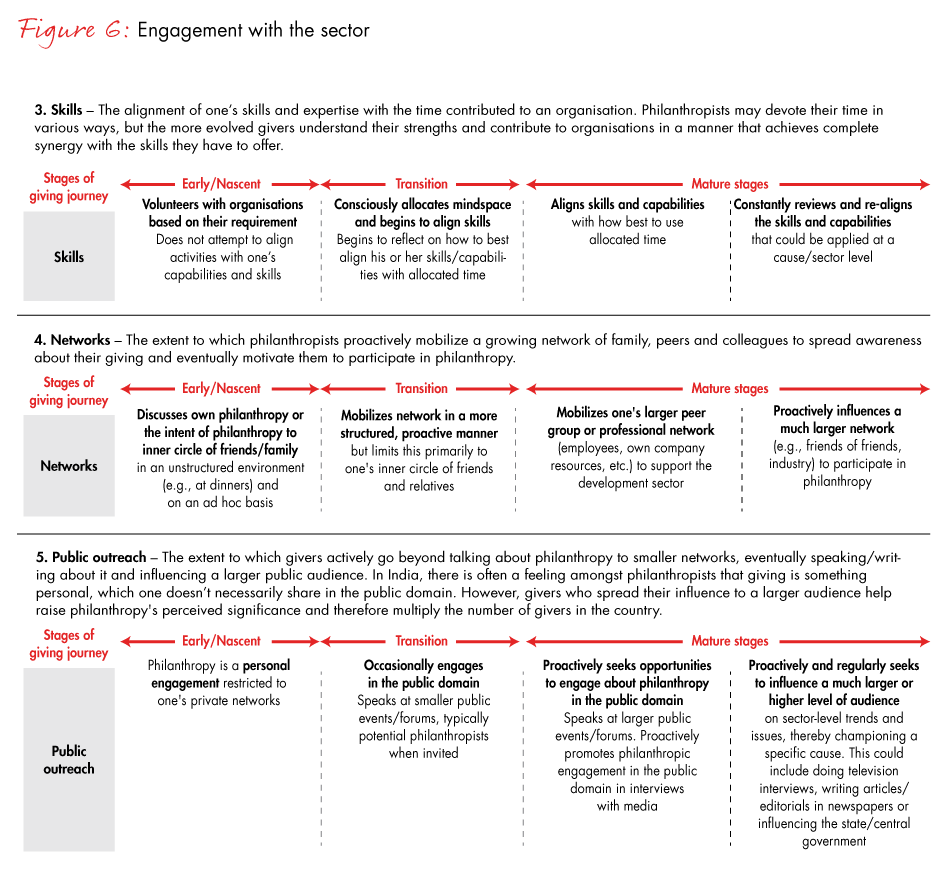
There is no such thing as a “right” way to give. A giver may be at different stages across different factors. The philanthropic pathways framework isn’t meant to be prescriptive. Rather, it allows givers to understand their options and the different paths one’s philanthropy can take. Our hope is that givers will use this framework to understand all of the possible methods of engaging with philanthropy and choose the ones to which they are best suited. It is a practical tool that they can use to better understand how they can maximise their contribution and can also be used by philanthropic advisers to help guide givers.
Different giver cohorts take different approaches to philanthropy, each adding value in its own way
Based on the factors outlined in the framework, a survey of 33 philanthropists was conducted (see Figure 7). The results indicated that most philanthropists broadly fall into one of four different philanthropic cohorts. Each cohort shares key characteristics, outlooks and practices that shape its overall approach to philanthropic engagement. The different groups include: “the striving seeker,” “the professional partner,” “the capital contributor” and “the enlightened evangelist” (see Figure 8). We will look more deeply into how givers in each of these cohorts tend to approach their giving. We’ll also examine some of the challenges they face and offer suggestions on how to overcome those challenges.
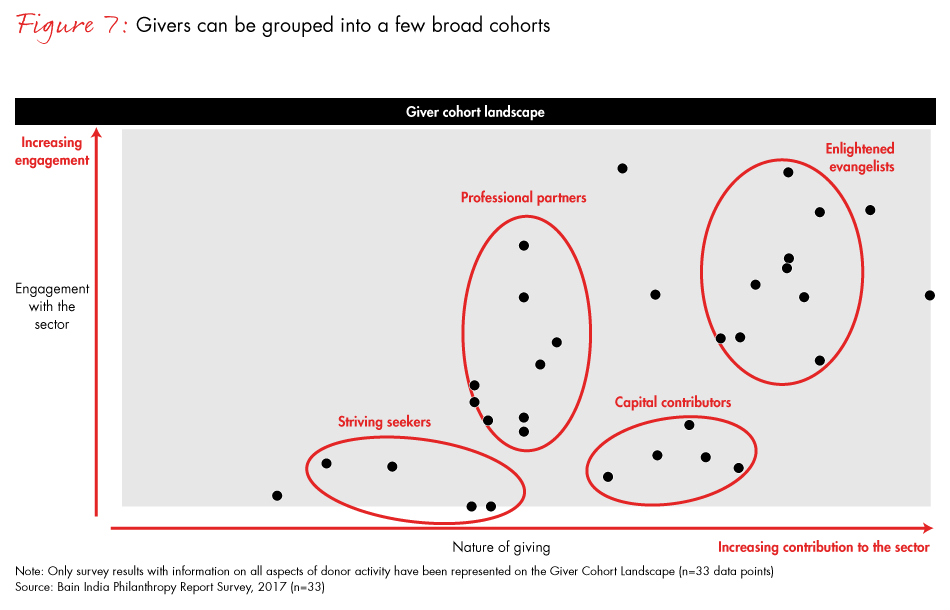
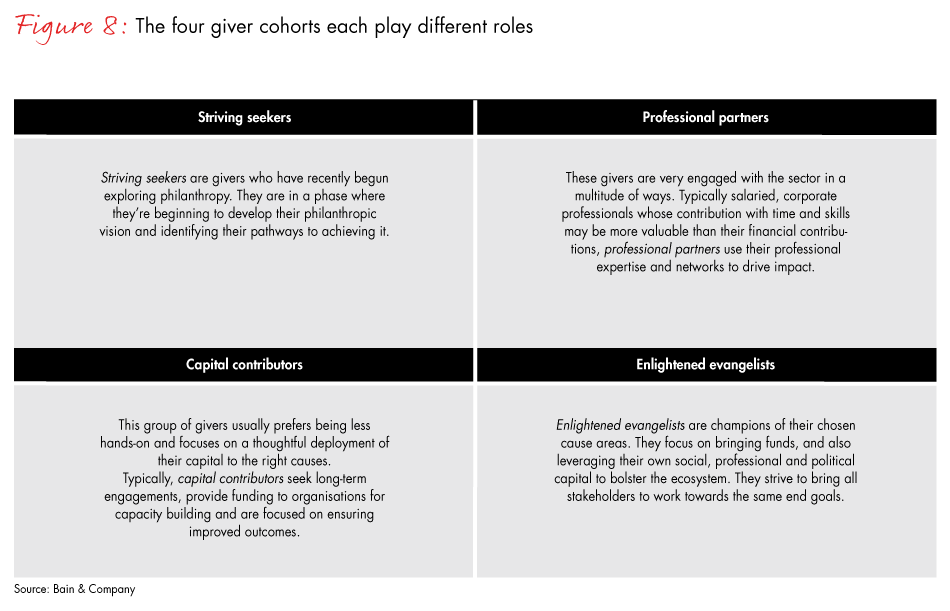
The cohort in which a giver is positioned does not change the potential impact he or she can achieve. Each philanthropist in a cohort adds value and must be applauded. However, the manner in which different cohorts go about their philanthropy is different. It is crucial to understand what roles each of these cohorts play in solving development sector issues and how givers can go about improving their ongoing philanthropic activities to maximise their impact.
Givers in each cohort can reach their full potential in multiple ways
The pen portraits below provide illustrative examples of how givers in each of the four cohorts may choose to engage with philanthropy. They also outline some specific challenges they might face, as well as strategies and tools they can use to be more effective.
“The striving seeker”: Seeking opportunities to learn as a giver
Even though she is an accomplished doctor and professional pianist, Myra is aware that there is always room for learning and growth in what she does. Her approach to philanthropy is similar. Before deciding where to give, Myra spends a significant amount of time understanding the sectors that interest her. Specifically, she studies research reports and reads articles online. She also speaks to experts about the gaps in a sector, effective interventions to address these gaps, and areas that need the most attention from philanthropists.
Myra also takes time every year to visit programme sites and interact directly with beneficiaries. This enhances her understanding of the challenges they face on the ground and how she can best help address them. In addition to learning about nonprofit issues and work, Myra spends significant time interacting with peer philanthropists. She hears about the challenges they have faced and lessons they have learned through their giving journeys, both formally (for instance, through donor education programmes and at philanthropy forums/events) as well as informally (for instance, at casual social gatherings). Such opportunities for learning keep her fulfilled and motivated, and push her to be a better giver every day.
Practical tips to attain full potential
- Understand the motivation for giving. Those who have just begun their philanthropic journeys need to first conceptualise and then articulate their reasons for philanthropy. They should determine what they are passionate about and what causes resonate with them and why. The Socratic method of dialogue is one effective way of challenging these beliefs; it pushes people to arrive at the base assumptions behind their thinking. Engaging family members in conversation about philanthropy is another helpful idea.
- Expand education. For seekers, it is easy to get inundated with information and be overwhelmed by the multitude of causes and hundreds of organisations, each with its own approach. It is important for the seeker to educate himself or herself about the sectors in which they are interested. There are multiple ways to do this: Engage with peer philanthropists, and learn from experienced ones who can share perspective on their efforts and successes. Seek out meaningful immersion within nongovernmental organisations (NGOs) at least a few days a year, to best understand their functions, and find structured learning opportunities such as giver education programmes. Attending formal events where philanthropists and thought leaders speak about philanthropy is also a great way to learn.
- Build trust. Identifying organisations to partner with can be a daunting task for someone who has just begun the journey in philanthropy. Building trust in organisations, especially in India, is not always easy. To overcome this, meet with leaders of promising organisations, speak to experienced philanthropists so that one can give to the same organisations, and work with philanthropic advisers and intermediaries who can establish the credentials of the organisation. Seekers can also refer to certifications such as the GiveIndia or GuideStar.
Watch outs
A potential impediment for a seeker is often what is called “analysis paralysis,” or the hesitance to begin. First-time givers are held back by the fear of not knowing what kind of impact to expect, how to define success or failure in philanthropy, which models are most effective or whether the funds will be effectively used. Therefore, in the early years, a giver is encouraged to give to multiple organisations and sectors, an approach that will help them articulate their philanthropic vision and understand the nuances of the development sector. We recommend picking an area of interest within the first few years of one’s philanthropic journey and allowing one’s interests and focus to evolve. The first key step is to simply get started.
“The professional partner”: Leveraging professional skills for philanthropy
Vikram strongly believes that his business and philanthropy worlds are closely linked and that by applying his business skills to philanthropy, he can help nonprofits increase their impact in important ways that funds alone would not allow. As an executive at a large IT firm, Vikram recognised that almost all the nonprofits he was supporting were struggling to collect, analyse and visualise their data. He decided to spend a significant amount of his time understanding the technological challenges of nonprofits and worked with them to identify relevant solutions that would help enhance their impact.
Today, Vikram serves as a consultant to more than 20 nonprofits across India. He advises them on relevant technologies, designing and customising solutions for their needs and training staff to effectively use these new technologies. He has also convinced his peers and employees to volunteer their time working with these organisations to increase the nonprofits’ understanding of technology. Vikram continues to align his expertise in technology with his philanthropic contribution, with the knowledge that by leveraging his skills, he is able to amplify the impact of his philanthropy and help nonprofits reach their goals better and faster.
Practical tips to attain full potential
- Start with self-reflection. Every organisation requires a few common skills, and professional partners can help organisations in ways above and beyond the funds they contribute. The scope and scale of these activities is restricted only by one’s imagination. It could mean helping an organisation improve its operational capabilities, plan its recruitment, implement technology, raise funds or enhance marketing and communications. Or it could involve applying one’s knowledge of strategy towards helping the organisation achieve its vision. A practical way for professional partners to begin: Identify skills and expertise and speak to other philanthropists about how they began contributing to the sector.
- Identify problems and align expertise. The next step is to identify problems in organisations that one’s expertise is suited to address. Spending time with an organisation over the course of a few months is the best way to do this. Deep immersion allows givers to understand problems from the lens of a third party as well as from the perspective of the organisation facing the problem.
- Aim for repeatability. Givers should also focus on ensuring that their actions go beyond one-time engagements. The aim should be to ensure repeatability, sustainability and scalability of their efforts. If they have successfully completed a volunteering drive within the company they work for, could it be made a repeat annual engagement? Instead of advising an organisation on a one-off basis, could they consider taking a seat on its board? If they have helped the organisation develop a good way of reporting and tracking impact, can it be made modular and shared with organisations that do similar activities? A way to do this is to find examples of prior experiences and reflect on how one can take these initiatives forward.
Watch outs
Corporate professionals with a strong desire to engage in meaningful philanthropy often tend to be restricted by the quantum of their giving. They overlook the fact that their leadership experience and industry-specific skills are of just as much, if not more, value to NGOs than their capital. This approach typically asks the giver to invest their time to work with an organisation’s leadership to understand the structure, growth trajectory and challenges and then provide relevant support. To get started, earmark a percentage of time to offer to philanthropic efforts. As one moves ahead in his or her giving journey, the allocation of time and degree of involvement can increase. Or, if the giver is unable to spend his or her own time, we advise them to use his or her corporate resources, networks and partners to provide the support required.
“Capital contributors”: Supporting unique, underfunded causes
As a full-time businessman who leads a growing company, Ravi is unable to spend a large portion of his time on philanthropy. Instead, he focuses on how to most effectively deploy his funds. Ravi is well aware that certain causes attract a lot of attention from philanthropists, while others, despite having an equal or greater level of significance, receive scant attention. Ravi’s vision has always been to create the largest possible impact through his giving. He knows that the impact he would be able to achieve by giving to a sector such as education, which is already considerably saturated in terms of philanthropic funding, would be less significant than what he could achieve by giving the same amount to a relatively underserved area. He also believes that if a majority of philanthropists focus all their efforts on a select few causes and ignore others, India will never truly achieve holistic progress as a country.
Because of this philosophy, Ravi decided to focus his giving towards improving mental healthcare in India—an area that has rarely caught givers’ attention, largely because of the immense stigma surrounding the subject and the intangibility of outcomes that indicate success. He also supports organisations that work to improve governance systems in India; he understands that good governance is the backbone of meaningful, scalable change across sectors, yet philanthropists typically shy away from associating themselves with programmes that improve government systems’ efficacy, often for fear of being viewed as anti-government. Today, Ravi continues to support causes he believes need much more visibility and support than they are receiving. Knowing that he is a big fish in a small pond allows him to keep going every day and to dream of the immense change he can effect through his giving.
Practical tips to attain full potential
- Manage a portfolio. The first step for capital contributors is to assess how they can manage their philanthropic portfolio. Given the high quantum of funds channelled to philanthropy, it becomes difficult to monitor these on a regular basis. A lot of philanthropists prefer putting in a team to do this full time. Putting a dedicated professional team towards managing one’s philanthropy helps capital contributors manage their portfolios. The other ways to do this are to set up a foundation, engage with consultants or work with philanthropic intermediaries and advisers.
- Identify smarter vehicles of giving. Capital contributors are often unable to spend adequate time identifying the right organisation with which to partner. One alternative is for givers to work with the larger philanthropic community. Teaming up with other philanthropists who are pooling funds towards a cause is a good way to identify opportunities. Giving circles and pooled funds have demonstrated success. Giving to an intermediary that channels funds to other organisations is also a good way to start.
- Seek funding gaps and plug them. As most givers do, capital contributors often begin their journey by supporting the programmatic needs of NGOs. As they progress, they should seek opportunities to give to underfunded areas and issues. Investing in research, evaluation, advocacy and providing institutional building support to NGOs are some ways in which capital contributors create more impact with their giving.
Watch outs
Capital contributors can run the risk of feeling removed from the change on the ground. They can avoid this by keeping up to date on the impact of their giving. Helping organisations put reporting systems in place or putting together a professional team to aid grantee organisations helps ensure that the giver is updated about the changes in the sector.
“The enlightened evangelist”: Transforming an ecosystem through philanthropy
Shalini knows that the failure of the Indian sanitation system not only undermines the dignity of those who lack access to adequate sanitation facilities but also puts India’s overall development at risk. She understands that while private philanthropic initiatives have gained momentum in recent years, systemic change has yet to be realised. Shalini decided to take up the challenge of improving India’s sanitation, with an awareness that this grand feat cannot be accomplished alone.
At the core of her belief is the idea that only a long-term, catalytic approach that brings in stakeholders at every level will truly achieve deep-rooted systemic change. In line with this philosophy, Shalini invested time to educate herself about prominent gaps in the sanitation sector—from research to behaviour change and policy. She subsequently set up a philanthropic foundation that addresses these gaps at various levels. Specifically, the foundation supports and builds the capacity of existing nonprofits in the sanitation space, serves as a platform for entrepreneurs to come together and exchange ideas, creates a research base for evidence-based policymaking, and advocates with state- and national-level governments to implement systemic reforms.
At its core, Shalini’s philanthropic effort goes beyond supporting a portfolio of existing sanitation nonprofits; it is designed to catalyse a sanitation reform movement in the country. While she is aware that this may, at the outset, seem like an over-ambitious vision, she has a strong conviction that, with support from the right partners (namely, the government, consultants, nonprofits, academic institutions, think tanks), the Indian sanitation system is something that she can transform during her lifetime through philanthropy.
Practical tips to attain full potential
- Plan for the future. An enlightened evangelist should realise their full giving potential and assess the extent of his or her contributions against this full potential. A way to understand one’s giving potential is to figure out one’s future planning and understand the other possible avenues in which wealth can be deployed. Private wealth managers can help givers identify giving potential.
- Be proactive in outreach. Being an enlightened evangelist is an extremely important responsibility, as organisations count on these givers to bring the ecosystem together. Enlightened evangelists should understand that as philanthropists of repute, their every action goes a long way in advancing the cause. Reflection upon the multiplicative effects of one’s influence is useful in understanding the extent to which one can engineer change. We recommend being proactive in collaboration, seeking opportunities to engage the public, bringing together peers to share best practices and mentoring striving seekers who have just begun their journeys.
- Government engagement. In addition to matching potential philanthropists with organisations, it is important for givers in this cohort to engage with the government—often the largest and most powerful agent of change. A good way to start is by engaging with the more accessible local government and connecting it with organisations that might need its support.
Watch outs
Enlightened evangelists sometimes experience “donor fatigue”—that is, the feeling that their efforts are not yielding commensurate results. Given the scale of problems in India, philanthropists should understand that transforming an ecosystem takes time. They should set incremental goals that allow them to measure progress on the long path to success.
Every giver, whether he or she contributes funds, time or a mixture of both, plays a critical role in tackling India’s problems. Given the scale and scope of India’s problems, each and every philanthropist must achieve their full potential to move the needle in improving the state of India’s development sector. In the next section, we share with you a few case studies of givers who have transitioned through various stages of their lives and have adopted a number of methods to achieve impact.
Giving journeys: Following in the steps of impact
Ultimately, each giver has his or her own unique way of contributing towards solving some of India’s most challenging development problems. However, what’s common among every journey is a multifaceted and ever-evolving nature of philanthropy. The most effective philanthropists engage in constant self-reflection, and shift their actions and level of engagement according to what they believe is necessary to achieve their philanthropic goals. Below we highlight the giving journeys of four inspiring philanthropists, illustrating the various pathways they have walked to evolve as givers and eventually create greater impact through their philanthropy.
Archana Chandra, CEO of Jai Vakeel Foundation, and Amit Chandra, managing director at Bain Capital
Archana and Amit Chandra believe that every individual has a role to play in building a better society. Counted among the most thoughtful givers in India, they aim to give away at least 75% of their earnings every year. In addition, both of them invest a significant amount of their personal time—he devotes about half his time while she works full time in the development sector—trying to solve some of India’s most challenging issues. While they have come a long way, theirs is a journey that has been built on a series of small, thoughtful steps based on the principles of learning and sharing.
“Even when we didn’t have much money, we had some time and a little bit of knowledge.”
Inspired by Chuck Feeney’s “giving while living” philosophy, Amit’s journey started as a young banker, spending a couple of hours every other week on philanthropy. He began by observing and learning from NGO leaders such as Venkat Krishnan (founder of GiveIndia) and Shaheen Mistri (founder of Akanksha Foundation and current CEO of Teach for India). Archana, on the other hand, moved from the corporate sector in 2001 to dedicate all of her time to the Akanksha Foundation and learning the nuances of the development sector. She is currently the CEO of the Jai Vakeel Foundation, which serves the mentally challenged. Presently, Amit divides his time equally between the corporate world and the development sector, visiting nonprofits, sitting on nonprofit boards, helping with problem solving and influencing networks to support various causes.
“I felt completely empty despite having accomplished everything I could in banking.”
A critical turning point for Amit came around 2004–2005. “I took a sabbatical and undertook a spiritual course where I reflected on the purpose of my life. I concluded that if I was creating wealth then it must have a higher purpose for greater good.” This realisation led the Chandras to ask their financial adviser to undertake a meticulous evaluation of their income and assets and project what they needed to set aside to address the question, “What is enough?” Their primary objective was to decide what they could then allocate to philanthropy. The family decided that after hitting that target of “enough,” they would aspire to give away 75% or more of their annual income every year. The question that remained was how this wealth could be given away in the most effective way.
“We have engaged a team that is effectively our family office.”
Initially, the Chandras largely made grants to those organisations that approached them directly or a few organisations with which they were historically associated. However, as their giving scaled, they felt the need and saw an opportunity to drive greater impact. They decided to engage philanthropy advisers who have supported them since 2010. The advisers helped them think through their social investment strategy, undertook research and diligence, and provided support for meetings with government and other philanthropists and evaluated impact.
“Today, every rupee we spend should generate at least 100 rupees of impact. That equation was very different five years or 10 years ago.”
Engaging with philanthropy advisers, the Chandras said they realised, “We were perhaps spreading ourselves too thin.” Over time, they consolidated their investments, began giving longer, three- to five- year grants, and increased the level of their involvement with grantees. A turning point for them was collaborating with Mr. S. Ramadorai and Dr. Devi Shetty in setting up a world-class paediatric hospital in Mumbai. Not only did the Chandras commit to fund 10% of the cost, but they were instrumental in influencing many of their friends and corporate acquaintances to contribute a large part of the rest. “In essence, we got a massive multiplier for my social contribution to this worthy cause! Imagine if we could get that or more for every social investment we make.” The Chandras now consciously look for opportunities to use their funding or influence to create greater impact. They invest in a critical component—funding institutional costs such as human resources, information technology and marketing—“nonprogramme investments that a typical philanthropist would hate to fund but a corporation would not blink an eyelid to invest in.”
Lately, the Chandras’ giving approach has evolved to solving issues and having systemic impact. How can one successful template be replicated across hundreds of organisations? How can it influence policy? For instance, having found a template for a sustainable solution to the drought issue in Maharashtra, they are now presenting it to different state governments, corporations and philanthropists for wider-scale adoption.
“I just encourage people to go out and start their journey.”
Amit has always been inspired by stories of philanthropy. To lead the way, he has become more open about his philanthropy over the years. “I am shameless about pestering people when it comes to getting them involved. Sometimes they respond, and sometimes they don’t,” he says. “I think unless you begin the journey and start figuring out what works and what doesn’t, you can’t actually evolve your thinking. There are lots of things that we have done along our journey that were wrong, which became very important lessons to do things differently along the way.”
Rati Forbes, head of Forbes Marshall Foundation and director of Forbes Marshall
Indisputably one of the most prominent leaders of the philanthropy movement in Pune, Rati Forbes is becoming an inspiration to budding givers across India. Today, she spends a significant amount of her time leading the social initiatives of the Forbes Marshall group of companies. With perseverance, passion and an eagerness to impact the lives of the most vulnerable populations, Rati’s journey through philanthropy has been defined by continuous learning, growth and active involvement.
“I think early giving, in a way, was really giving of my time, giving of myself.”
Growing up around a father who served on the board of several corporations but also made time to do the same for nonprofits and a mother who, as a paediatrician, volunteered at clinics that served the less privileged, Rati understood the value of giving fairly early on. At age 14, she began volunteering at Samaritans, a suicide prevention centre. By 15, she was regularly reading to the blind. And at 21, she wrote a cheque from her first salary to an organisation supporting the blind.
“Initially, my giving was mainly from the heart, but increasingly now, the mind is leading.”
During the initial years, Rati’s giving decisions were largely emotionally led. She chose to support issues that were visible and tangible. “I started out on this journey because things I saw moved me. So for me, it started with the heart.” For example: “Every time I would go to the municipal schools we supported, I would be prepared to not have access to a clean toilet for at least three or four hours, and that made me think about how the children manage.” This experience led Rati to read about and enhance her understanding of the sanitation problem in India. In 2011, she engaged a philanthropy adviser to conduct in-depth research on the issues contributing to poor urban sanitation. She met with sector leaders such as Pratima Joshi, visited programme sites and eventually took up sanitation as a key area of focus at a time when funding toilets was almost unheard of in India.
Through her research and conversations with her philanthropy adviser, Rati’s understanding of the sector deepened, and she began to realise that without adequate governance structures in place, no amount of monetary support to sanitation nonprofits would lead to true improvement of India’s sanitation conditions. Meeting with peer philanthropists strengthened her belief in the importance of supporting governance, and in 2014–2015, she added this as another key area of focus.
“We started giving in a way so that organisations work to become sustainable. We also began thinking about collaboration—one of the most vital ingredients for long-term impact.”
As Rati got more involved, she began reflecting on how to generate maximum impact through her philanthropy and recognised three vital approaches. First, she found, spending time understanding the needs of nonprofits was as, if not more, valuable than writing them a cheque.
Second, she realised that she should go beyond supporting specific programmes, and fund institutional aspects. “I began to work with nonprofits to understand their needs and the aspects that would help them achieve scale and sustainability. IT systems, a strong second-line leadership, and impact assessment processes—these are all vital components that need support.”
Third, Rati saw that by partnering with a group of stakeholders, the impact of her efforts could be much stronger and more far-reaching. For example, to create systemic change within the school system in Pune, her foundation was one of the first to initiate partnerships with other corporations, consultants and the Pune Municipal Corporation. Rati believes strongly in the power of collaboration, and today she is working towards adopting a more collaborative approach to her giving.
“I’ve found that when I have talked to peers about philanthropy, it has been a great influencer in helping them to start thinking about their own giving journey.”
Rati has come to believe in the power of sharing her stories of giving, with the goal of influencing her close network to participate in philanthropy. From speaking informally to family and friends to hosting formal dinners that bring together local and international givers and industry partners to discuss philanthropy, Rati continues to widen the reach of her influence. As someone who has typically shied away from the spotlight, she has also grown more confident in extending her influence to a broader public audience through speaking at events and writing newspaper articles. “I don’t think it’s important to talk about how much you give, but it’s vital to get the message out there that it’s important to give. Personally, I think I’ve hugely grown and developed as a human being through my philanthropy journey, and it’s very satisfying to witness the impact of it.”
Hemendra Kothari, founder and chairman of Wildlife Conservation Trust and nonexecutive chairman of DSP BlackRock Investment Managers
Hailing from a family of stockbrokers, Hemendra Kothari is regarded as one of India’s most accomplished investment bankers. In the 1970s and 1980s, he convinced some of the biggest international players in banking to invest in India at a time when the financial services market was under state control. Today, that same perseverance guides him through his philanthropy. Since founding the Wildlife Conservation Trust (WCT) in 2001, he has devoted a substantial amount of his time towards building the ecosystem around conservation in India. He also focuses on education and healthcare through the Hemendra Kothari Foundation. Having traversed a journey defined by passion and professionalism, he has become a role model for givers who look to make a transformative impact in lesser-served sectors.
“There was a natural extension of values in our family; a sense of responsibility to give back to society was always prevalent.”
Growing up around a great-grandfather who founded a boarding and lodging hostel for outstation students who come to Mumbai for their college education and a father who set up a hospital in Mumbai, Hemendra had a strong family influence that helped shape his outlook on philanthropy early on. Similar to many others, he began his giving journey by continuing and honouring his forefathers’ philanthropic legacy. “My first experience of giving money was to the hospital that my father ran.”
“I started giving to wildlife funds because it excited me—there was not much thought. I feel very differently about wildlife now.”
After college, Hemendra visited Corbett National Park and saw his first big cat—a leopard. This sighting laid the foundation for his love of wildlife that then took him and his late wife on several wildlife trips across India and Africa. “We were just enjoying ourselves ... I started asking questions and realised that the parks required funds. So I started giving, without any particular reason, to their employees, welfare funds, et cetera.”
He began meeting sector leaders such as Bittu Sahgal to better understand the issues surrounding wildlife conservation. It was only then that he began to understand the meaning of conservation. “Of course, we need to protect the tiger, but at the same time, I realised that forests are plugged into the larger equation of water and climate change so are critical in themselves.” In 2001, he founded WCT. By travelling and studying the work of local and international wildlife organisations, he recognised the importance of educating and providing livelihoods to communities living around forests. Currently, WCT adopts a 360-degree approach to protecting India’s forests and wildlife.
“I realised that we can’t really do this on our own.”
Given the scale of Hemendra’s vision, he realised that his efforts alone would not be enough. “I understood that we need to bring together different stakeholders from across the country in order to multiply efficiency and avoid duplication of efforts.” Conversations with government officials helped him understand that quality training forest guards and support for their basic needs, including healthcare, is vital to ensuring their effectiveness. Hemendra has focused on building the government’s trust and demonstrating his own organisation’s credibility. “We help them see that we are not trying to compete with them in any way—that we are allies.” Today, the government is one of the biggest partners of WCT, which has a presence in more than 120 national parks and reserves in India.
Hemendra also became aware of the inadequate understanding of wildlife conservation among the public at large. He understood that no systemic change can occur without a general public sensitivity towards conservation. In 2009, WCT partnered with NDTV and Aircel to launch a major media campaign to increase public awareness about wildlife conservation.
Having partnered with several stakeholders, collaboration has been at the core of Hemendra’s vision to strengthen the ecosystem of conservation.
“I am an organisation builder, and started bringing that skill to my philanthropy.”
Because Hemendra was still heavily involved with his business while also heading WCT, he recognised the need to bring in greater resources. He started building a professional team that could devote 100% of its time, and in 2009, he brought in Anish Andheria to head the trust.
Additionally, Hemendra sought to apply the principles that he learned in the business world to his philanthropy. Anish Andheria reflected, “He runs this organisation with the same professionalism and urgency as other businesses he has run. Decisions are fast, commitments always honoured, donations debated furiously within the team, and employees respected and allowed the freedom to bring their expertise to the table.”
“I have made mistakes, and I will continue to make mistakes. But if my heart says I want to do something, I will still do it.”
Over the years, Hemendra’s passion for wildlife has propelled him to spread his influence to the largest audience possible. He actively serves on several government wildlife boards. He also writes newspaper articles and speaks at philanthropy events about the importance of conservation. Today, these efforts have made Hemendra a conservation icon in India. “What I hope is that people find the same satisfaction and joy in giving that I have experienced through my journey.”
Common themes in giving journeys
The path to achieving impact in the development sector is long, varied and inherently complex. There are, however, broad patterns in giving approaches that have proved to be effective. This report condenses the multitude of possibilities into an integrated framework and provides examples to help givers chart their philanthropic journey and navigate it towards greater impact.
Givers can use the philanthropic pathways framework to better understand the varied approaches to philanthropy. We encourage them to use this framework to identify the factors that align with their own vision and understand how they can more thoughtfully incorporate them in their giving. The giver cohorts provide structure to help givers reflect on their own giving approach, and their personification helps illustrate the activities one can undertake to increase their effectiveness. The stories of the Chandras, Rati Forbes and Hemendra Kothari not only provide real-life examples of how prominent philanthropists have evolved in their giving over the years but also illustrate the ever-changing nature of individual philanthropy.
As givers mature in their philanthropic outlook, reflect on their various engagements and evolve in their giving approach, we urge them to be cognisant of three critical aspects of a philanthropic journey.
- Constant change. The giving journey is one of constant change. Philanthropists change their engagement over the years as they learn from their own experiences and adapt and align their giving approach to their vision. This constant evolution is not just necessary but is almost inevitable. The need to evolve stands out in both the Chandras’ and Rati Forbes’ journeys—philanthropists who were always experimenting with new ways to create greater impact.
- Collaborative action. The scale of India’s problems is large, and the change needed is immense. This is not a task that one individual can face alone. In our conversations with philanthropists, the importance of collaborative efforts came up frequently. It is through meaningful engagement with a range of stakeholders, including philanthropist peers, that givers learn, grow and multiply the impact of their efforts.
- Continuous effort to attain full potential. The giving journey is a personal one as philanthropists strive to reach their potential. Through the case studies, what stands out is the value of doing one’s bit, regardless of scale, to the best of one’s abilities. Achieving one’s own potential is a key part of a donor’s responsibility towards the larger social collective.
We hope givers use this report to begin their journey and make it more fulfilling along the way. The first step in any journey to achieving full potential is self-reflection; givers can use this tool to better understand their motivation towards philanthropy and then develop and articulate their vision. Once philanthropists have defined their vision, they can develop their own giving approach or choose one of the many ways that exist, and make it their own. The experiences of philanthropists who have traversed this journey before them will help. Once givers have identified their path, the next step is progress, with incremental targets inching towards a broader goal. The path to a transformed India may be paved with uncertainty, but the journey promises to be a fulfilling one.
Through it all, givers may face barriers and challenges, successes and disappointments, but they must remain steadfast in one’s aim to do one’s best and achieve one’s full potential every step of the way. The long road ahead may be a marathon, but givers should aim for short sprints towards small victories, and share them with the community and peers.
The aim of this report is to inspire givers to achieve his or her full potential, and this goal can only be achieved if every one of us makes a conscious, deliberate effort to seek opportunities that increase the effectiveness of our philanthropy. Each and every philanthropist owes it to himself or herself to be the best giver he or she can be and to inspire others on the journey. The authors’ sincere hope is that this report is but a starting point which triggers meaningful dialogue, encourages philanthropists of all hues to share best practices, and energises all individual giving journeys.
Appendix
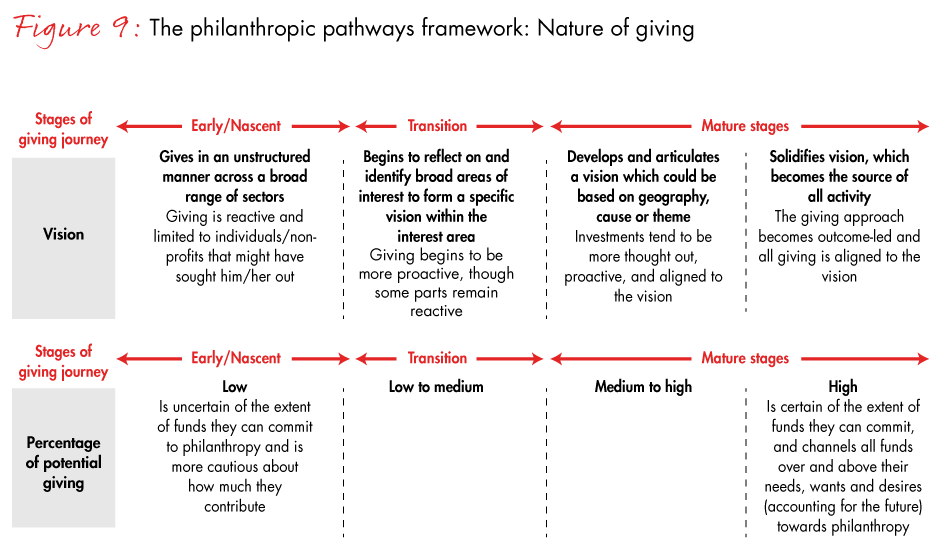
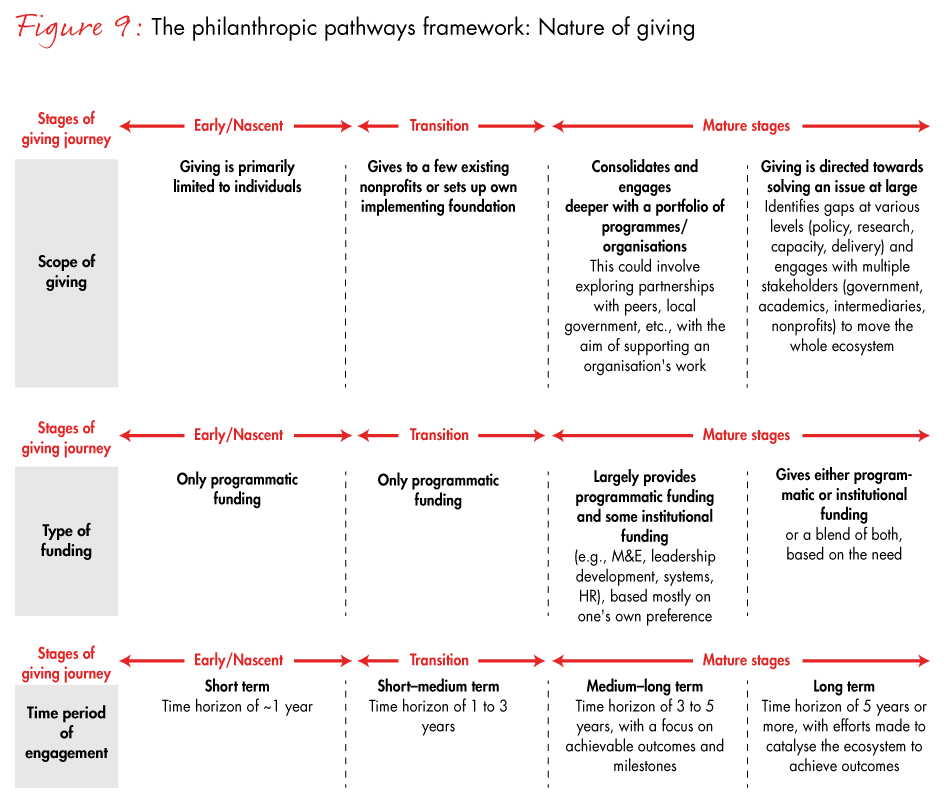
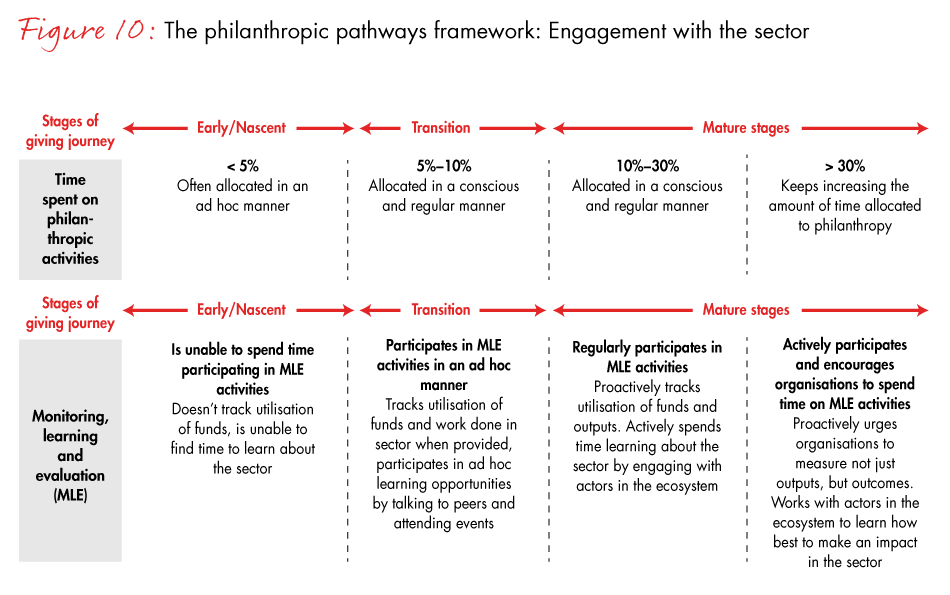
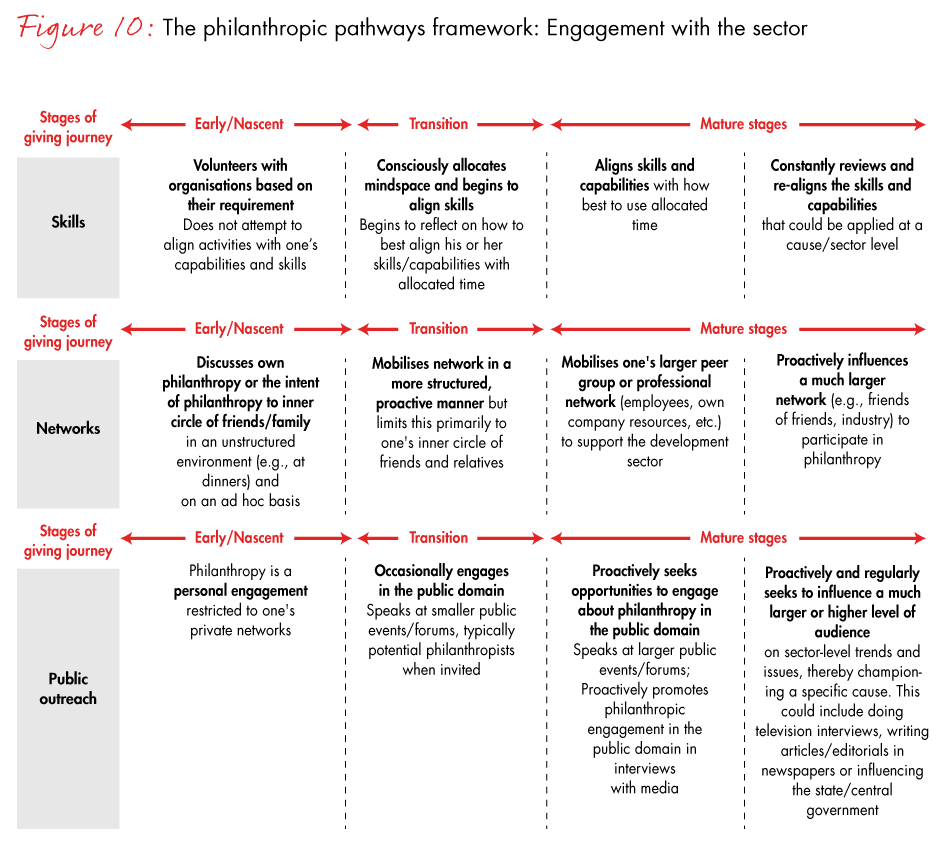
The report is the result of a collaboration between Bain & Company and Dasra. The report was prepared by Arpan Sheth, a partner with Bain & Company who leads the firm’s Private Equity practice in India; Deval Sanghavi, cofounder of Dasra; Anant Bhagwati, a partner with Bain & Company; Srikrishnan Srinivasan, a manager with Bain & Company; and Pakzan Dastoor, who leads the Knowledge Creation and Dissemination vertical at Dasra.
Dasra, meaning enlightened giving in Sanskrit, is a pioneering strategic philanthropic organisation that aims to transform India to a place where more than a billion thrive with dignity and equity. Since its inception in 1999, Dasra has accelerated social change by driving collaborative action through powerful partnerships among a trust-based network of stakeholders (corporations, foundations, families, nonprofits, socially responsible businesses, government and media). Over the years, Dasra has deepened social impact in focused fields that include adolescents, urban sanitation and governance, and it has built social capital by leading a strategic philanthropy movement in the country. For more information, visit www.dasra.org.













